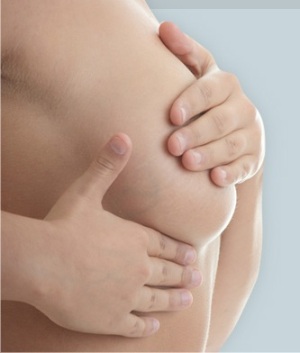Localized pain in the chest or abdomen may or may not be related to a serious condition, but it is always best to find out what causes it so that proper measures may be taken to treat it. Pain under right breast is not uncommon, and anyone can experience this. In considering the underlying problem, it is important to know what structures are in this area, as well as the accompanying symptoms that you are experiencing.

Possible Causes of Sharp Pain Under Right Breast
The area under the right breast consists of various structures, including the ribs and muscles in the chest, parts of the lung, and organs in the upper abdomen. Here are some possible medical conditions associated with it.
1. Rib Injury
The organs in the chest are protected by your rib cage, which is composed of ribs, cartilages, and a plate-like structure called the sternum. Sometimes, an injury to these structures, such as a fracture from a direct blow to the chest or a crush injury from a vehicular accident can lead to bruising, tenderness and pain in the affected area. Aside from these, sharp pain under the right breast may feel worse when you cough, sneeze or take deep breaths. It is best to get immediate medical attention after such injuries to prevent complications that may affect the underlying organs.
2. Costochondritis
Inflammation of the cartilage attached to a rib, or costochondritis, may result from trauma, violent coughing, infection, or strain injury to the affected joint. This is a common condition that causes chest pain and it usually feels worse with physical activity or when you sneeze or cough. However, it is not serious and is usually relieved with rest and OTC pain relievers.
3. Pleurisy
Inflammation of the lining of the lung and chest cavity (pleura) may result from respiratory infection, pneumonia, trauma or exposure to toxic substances such as asbestos. This condition, called pleurisy, is characterized by chest pain that becomes worse with coughing, deep breathing, and movement. Other symptoms include coughing, rapid breathing, and shortness of breath.
4. Pancreatitis
The pancreas is a large organ located behind your stomach, which is in the left upper abdomen. Although it is located on the opposite side, inflammation of this organ (pancreatitis) can cause an acute or chronic pain that can be referred or transmitted to another part of the body, such as that causing sharp pain under right breast.
Pancreatitis may result from infection, blockage of ducts, alcohol abuse, high triglyceride levels, or presence of stones in the gallbladder. Pain may also be referred to other areas, such as the back or the sides of the abdomen, and can cause other symptoms such as fever, nausea, vomiting, and bloating. These symptoms may feel worse after eating a meal high in fat.
5. Gallbladder Disease
The gallbladder is a small sac located under your liver in the upper side of your abdomen. This serves to store and release bile, a digestive juice produced by your liver. When the bile, which contains salts, pigments, and cholesterol, crystalizes and forms stones (gallstones), a condition called cholelithiasis occurs. Infection may also occur, thus causing inflammation (cholecystitis), which may lead to pain under right breast. This pain usually radiates to the back and causes other symptoms such as fever, nausea, and vomiting.
6. Kidney Stones
Renal calculi or kidney stones are hard deposits that develop when acid salts and minerals crystalize in the urine. Small kidney stones usually pass in the urine causing no problems, but larger ones can cause severe pain, which may be felt when they get lodged in your kidney or ureter. Although the most common symptom is flank pain, which is felt on the side of the affected kidney, the pain may radiate to your rib cage, causing sharp pain under right breast. Other symptoms include fever, nausea, vomiting, frequent urination, cloudy urine, and burning sensation when urinating.
7. Hiatal Hernia
This less common condition results when part of your stomach protrudes (or herniates) through a weak area (hiatal opening) in the diaphragm, which opens into the chest cavity. Sometimes, part of the esophagus (the tube leading to the stomach) also herniates through this hiatus. These conditions often cause shortness of breath, chest pain, heartburn and bloating after meals. Immediate treatment is necessary to avoid serious complications.
Diagnosing the Pain
If you have recently been exercising and your symptoms are stable (not worsening), the sharp pain under right breast may just be a temporary condition related to strain (costochondritis). This is one of the most common causes of pain in the chest and it may resolve with rest and pain relievers.
However, if you have been involved in a recent trauma or had a serious respiratory infection, it is best to see a doctor right away. Sometimes, you may not be aware that you have symptoms of a disease affecting the organs of your upper abdomen or the kidneys, so it is advisable to consult a doctor for proper diagnosis and management.
Tests may include various blood tests, urine examination and imaging exams like ultrasound, X-ray, MRI, or CT scan, depending on your physician’s assessment after he takes your medical history and physical examination.
